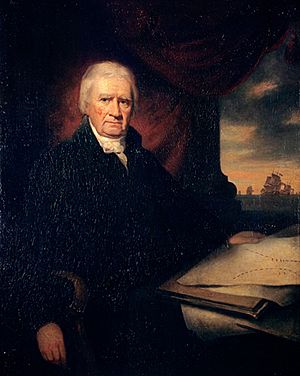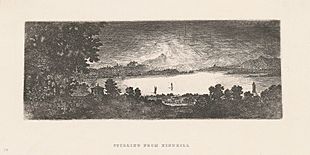John Clerk of Eldin facts for kids

John Clerk of Eldin (FRSE FSAScot) (born December 10, 1728 – died May 10, 1812) was a talented Scottish person who was a merchant, writer, artist, geologist, and landowner. He was the seventh son of Sir John Clerk of Penicuik. John Clerk of Eldin was an important figure during the Scottish Enlightenment, a time when new ideas and discoveries were very popular. He is best known for his important writings about how to fight battles at sea with sailing ships. He was a friend of the geologist James Hutton, and his brother-in-law was the famous architect Robert Adam. He was also a great-great-uncle of the brilliant physicist James Clerk Maxwell.
About John Clerk of Eldin
John's father, Sir John Clerk, 2nd Baronet of Penicuik, was a judge and politician. He helped with the talks that led to the Acts of Union 1707, which joined Scotland and England. Young John went to Dalkeith Grammar School and was known as a very good student. He started studying medicine at the University of Edinburgh, as his father wanted him to be a "top surgeon." However, John decided to stop his studies and go into business instead.
Clerk became rich as a merchant, selling cloth, and by managing a coal mine. In 1763, he earned enough money to buy a property called Eldin in Lasswade, near Edinburgh. There, he spent his time on science and art. In 1753, he married Susannah Adam, who was the younger sister of his close friend, the architect Robert Adam. They had seven children, but sadly, all of them died without getting married.
In 1783, John Clerk helped start the Royal Society of Edinburgh, a group for important thinkers and scientists.
By 1793, Clerk had retired from business. He moved between his home at Eldin and a house he bought in Edinburgh in 1788. This house on Princes Street had a great view of Edinburgh Castle. Like many people during the Enlightenment, he had many different interests. These included geology (the study of Earth's rocks and soil), architecture (designing buildings), and art. In the 1780s, he went on several trips with his friend James Hutton to study geology. He also helped Hutton by drawing pictures for his famous book, Theory of the Earth. He also went on sketching tours with Robert Adam. John Clerk died peacefully at Eldin on May 10, 1812, surrounded by his family.
From a young age, John Clerk was very interested in ships and sailing. He made friends with ship owners, sailors, and others involved in sea travel. He met an engineer named Patrick Miller of Dalswinton, who encouraged his interest in everything about ships.
Around 1770, a former officer from the Royal Navy, Commissioner Edgar, retired to Eldin, where Clerk lived. They met, and Edgar shared many stories about his time at sea. He had served under Admiral John Byng and was a friend of Admiral Edward Boscawen. Edgar was very interested in naval tactics, and he became a key source of information for Clerk's writings. Clerk not only used Edgar's experiences but also researched naval tactics by reading stories from old officers and about past battles. These included battles in the Mediterranean Sea during the War of the Austrian Succession in 1744 and more recent events like the Battle of Ushant.
The unexpected British defeat at the Battle of the Chesapeake might have made Clerk decide to move from just studying tactics to writing his own ideas. When he did this, he created new ideas for English naval tactics. Before him, there were technical books like signaling guides, but no one had written a full study of naval tactics in English.
In his book Essay on Naval Tactics (written in 1779, published in 1790), Clerk explained a tactic called "cutting the line." This meant sailing into the enemy's line of ships and attacking the ships at the back of their line with all your own ships. This was a very clever idea! The famous Admiral Horatio Nelson even used some sentences from Clerk's work in his orders to the British fleet before the important Battle of Trafalgar.
His Etchings
John Clerk of Eldin learned to draw when he was young. His father, Sir John Clerk of Penicuik, believed that drawing was very important. He said it was the "best means of advancing their fortunes" for young men, because they needed to know how to draw a country, a town, a house, or a castle to be good soldiers or sailors. Clerk and his friend Robert Adam often went out drawing together. In the late 1740s, they were joined by a younger artist named Paul Sandby, who later became a well-known English draughtsman. The oldest drawings by Clerk that we know of are from around 1750. Because the three men were friends, their drawing styles were quite similar at that time. Clerk mainly drew landscapes, often focusing on historical buildings.
Even though Clerk knew Sandby's etchings, Clerk himself didn't mention having any teachers for etching. So, we think he taught himself. However, he would have known engravers in Edinburgh if he needed advice. One person was Andrew Bell (1726-1810), who had learned from Richard Cooper the Elder (1701-1764). Cooper's workshop was very respected and would have been a good place for anyone wanting to learn printmaking. Cooper worked for both Sir John Clerk of Penicuik and William Adam, so he was well connected to Clerk's family and friends.
Clerk's early work in etching seemed a bit random, like he was learning by trying things out. Overall, John Clerk of Eldin made over 110 etchings. His first ones were around 1770, and his last in 1778. It's hard to say exactly when he started; he once said he began at age 45 (in 1773), but we have dated works from 1772, and they are too good for a complete beginner. Clerk made sets of etchings that he sold. He printed them when people ordered them. Later, he passed this job to Thomas Philipe, a "Printseller" in Edinburgh. Clerk's images, made in a style similar to famous European printmakers, beautifully show the castles and ruins of Scotland. They are charming and surprisingly good quality for someone who was not a professional printmaker.
After he died, his family kept his collection of prints and plates. In 1825, with help from his son John Clerk, Lord Eldin, a group called the Bannatyne Club in Edinburgh published a book of his etchings called 'Etchings, Chiefly Views of Scotland by John Clerk of Eldin'. This book had 26 pictures. In 1855, the Bannatyne Club published another version with 76 etchings, because more plates had been found at Eldin. It is believed that the Bannatyne Club then destroyed the plates because their quality had become very poor.
His Legacy
The famous writer Sir Walter Scott described John Clerk of Eldin in his book Guy Mannering like this:
"You who love original people should visit Edinburgh to see this amazing man. The table where he sits is covered with all sorts of things—paints and crayons, clay models, books, letters, tools, different kinds of rocks, bottles with chemicals for experiments, maps of old and new battles, models of new machines, and music sheets. It's like a messy mix of literature and science!"


